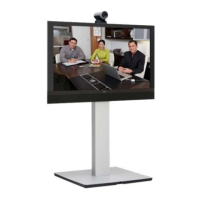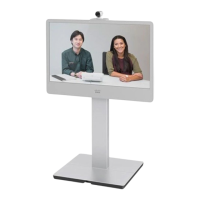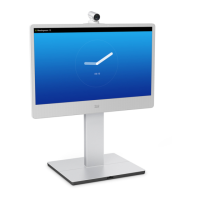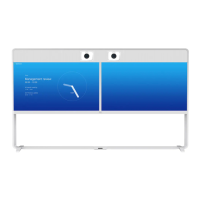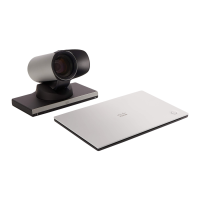D15119.02 MX700 and MX800 Administrator Guide TC7.2, AUGUST 2014. www.cisco.com — Copyright © 2014 Cisco Systems, Inc. All rights reserved.
100
Cisco TelePresence MX700 and MX800 Administrator Guide
SIP Profile [1..1] Turn Password
The password needed for accessing the TURN server.
Requires user role: ADMIN
Value space: <S: 0, 128>
Format: String with a maximum of 128 characters.
Example:
SIP Profile 1 Turn Password: ""
SIP Profile [1..1] URI
The SIP URI (Uniform Resource Identifier) is the address that is used to identify the video
system. The URI is registered and used by the SIP services to route inbound calls to the
system. The SIP URI syntax is defined in RFC 3261.
Requires user role: ADMIN
Value space: <S: 0, 255>
Format: String with maximum 255 characters and compliant with the SIP URI syntax.
Example:
SIP Profile 1 URI: "sip:firstname.lastname@company.com"
SIP Profile [1..1] DisplayName
When configured the incoming call will report the DisplayName instead of the SIP URI.
Requires user role: ADMIN
Value space: <S: 0, 255>
Format: String with a maximum of 255 characters.
Example:
SIP Profile 1 DisplayName: ""
SIP Profile [1..1] Authentication [1..1] LoginName
This is the user name part of the credentials used to authenticate towards the SIP proxy.
Requires user role: ADMIN
Value space: <S: 0, 128>
Format: String with a maximum of 128 characters.
Example:
SIP Profile 1 Authentication 1 LoginName: ""
SIP Profile [1..1] Authentication [1..1] Password
This is the password part of the credentials used to authenticate towards the SIP proxy.
Requires user role: ADMIN
Value space: <S: 0, 128>
Format: String with a maximum of 128 characters.
Example:
SIP Profile 1 Authentication 1 Password: ""
SIP Profile [1..1] DefaultTransport
Select the transport protocol to be used over the LAN.
Requires user role: ADMIN
Value space: <TCP/UDP/Tls/Auto>
TCP: The system will always use TCP as the default transport method.
UDP: The system will always use UDP as the default transport method.
Tls: The system will always use TLS as the default transport method. For TLS connections
a SIP CA-list can be uploaded to the video system. If no such CA-list is available on the
system then anonymous Diffie Hellman will be used.
Auto: The system will try to connect using transport protocols in the following order: TLS,
TC P, U DP.
Example:
SIP Profile 1 DefaultTransport: Auto
SIP Profile [1..1] TlsVerify
For TLS connections a SIP CA-list can be uploaded to the video system. This can be done from
the web interface.
Requires user role: ADMIN
Value space: <Off/On>
Off: Set to Off to allow TLS connections without verifying them. The TLS connections are
allowed to be set up without verifying the x.509 certificate received from the server against
the local CA-list. This should typically be selected if no SIP CA-list has been uploaded.
On: Set to On to verify TLS connections. Only TLS connections to servers, whose x.509
certificate is validated against the CA-list, will be allowed.
Example:
SIP Profile 1 TlsVerify: Off

